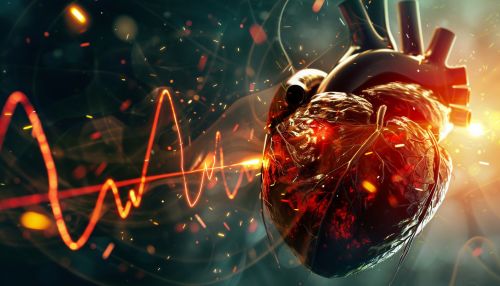Arrhythmias: Difference between revisions
(Created page with "== Definition and Types of Arrhythmias == An arrhythmia is a disorder of the heart that affects the regularity of the heartbeat. It is characterized by abnormal electrical impulses in the heart, which may cause the heart to beat too fast, too slow, or irregularly. This condition can lead to a variety of health complications, including stroke, heart failure, and sudden cardiac death. <div class='only_on_desktop image-preview'><div class='image-preview-loa...") |
No edit summary |
||
| Line 3: | Line 3: | ||
An [[Arrhythmia|arrhythmia]] is a disorder of the heart that affects the regularity of the heartbeat. It is characterized by abnormal electrical impulses in the heart, which may cause the heart to beat too fast, too slow, or irregularly. This condition can lead to a variety of health complications, including stroke, heart failure, and sudden cardiac death. | An [[Arrhythmia|arrhythmia]] is a disorder of the heart that affects the regularity of the heartbeat. It is characterized by abnormal electrical impulses in the heart, which may cause the heart to beat too fast, too slow, or irregularly. This condition can lead to a variety of health complications, including stroke, heart failure, and sudden cardiac death. | ||
[[Image:Detail-77907.jpg|thumb|center|A close-up image of a heart with electrical impulses indicating the heartbeat.|class=only_on_mobile]] | |||
[[Image:Detail-77908.jpg|thumb|center|A close-up image of a heart with electrical impulses indicating the heartbeat.|class=only_on_desktop]] | |||
Arrhythmias can be classified into two main types: tachycardia and bradycardia. [[Tachycardia|Tachycardia]] refers to a heart rate that exceeds the normal resting rate, typically greater than 100 beats per minute in adults. On the other hand, [[Bradycardia|bradycardia]] is a condition where the heart rate is slower than normal, usually less than 60 beats per minute in adults. | Arrhythmias can be classified into two main types: tachycardia and bradycardia. [[Tachycardia|Tachycardia]] refers to a heart rate that exceeds the normal resting rate, typically greater than 100 beats per minute in adults. On the other hand, [[Bradycardia|bradycardia]] is a condition where the heart rate is slower than normal, usually less than 60 beats per minute in adults. | ||
Latest revision as of 10:24, 8 May 2024
Definition and Types of Arrhythmias
An arrhythmia is a disorder of the heart that affects the regularity of the heartbeat. It is characterized by abnormal electrical impulses in the heart, which may cause the heart to beat too fast, too slow, or irregularly. This condition can lead to a variety of health complications, including stroke, heart failure, and sudden cardiac death.


Arrhythmias can be classified into two main types: tachycardia and bradycardia. Tachycardia refers to a heart rate that exceeds the normal resting rate, typically greater than 100 beats per minute in adults. On the other hand, bradycardia is a condition where the heart rate is slower than normal, usually less than 60 beats per minute in adults.
Causes and Risk Factors
Arrhythmias can be caused by a variety of factors. These include heart disease, high blood pressure, diabetes, and certain genetic disorders. Lifestyle factors such as smoking, excessive alcohol consumption, and use of certain medications or drugs can also contribute to the development of arrhythmias.
Risk factors for arrhythmias include age, family history of heart disease, and certain medical conditions such as thyroid disorders and sleep apnea. Stress and anxiety can also trigger arrhythmias in some individuals.
Symptoms and Diagnosis
Symptoms of arrhythmias can vary widely depending on the type and severity of the condition. Some people with arrhythmias may not experience any symptoms, while others may experience palpitations, dizziness, shortness of breath, chest pain, or fainting.
Diagnosis of arrhythmias typically involves a physical examination, medical history, and various tests such as an electrocardiogram (ECG), Holter monitor, event recorder, and cardiac catheterization. In some cases, a stress test or tilt table test may also be performed.
Treatment and Management
Treatment for arrhythmias depends on the type and severity of the condition. Some arrhythmias may not require treatment, while others may require medication, lifestyle changes, or medical procedures such as cardioversion or ablation. In severe cases, a pacemaker or implantable cardioverter-defibrillator (ICD) may be needed.
Management of arrhythmias involves regular monitoring and follow-up with a healthcare provider, taking prescribed medications as directed, and making lifestyle changes such as quitting smoking, limiting alcohol consumption, maintaining a healthy weight, and managing stress.
Prevention
Prevention of arrhythmias involves managing underlying conditions that can increase the risk of developing arrhythmias, such as high blood pressure and heart disease. Lifestyle changes such as eating a heart-healthy diet, getting regular exercise, quitting smoking, limiting alcohol consumption, and managing stress can also help prevent arrhythmias.
